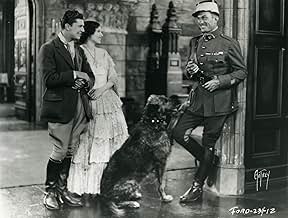"Citizen" Hogan, an exile Irish patriot, risks his life by returning to Ireland and helping a young couple."Citizen" Hogan, an exile Irish patriot, risks his life by returning to Ireland and helping a young couple."Citizen" Hogan, an exile Irish patriot, risks his life by returning to Ireland and helping a young couple.
Joseph Burke
- Neddy Joe - Dermot's Servant
- (uncredited)
Mike Donlin
- Racetrack Informant
- (uncredited)
Mary Gordon
- The Woman at Hogan's Hideout
- (uncredited)
Brian Desmond Hurst
- Horse Race Spectator
- (uncredited)
Eric Mayne
- Colonel of Legionnaires
- (uncredited)
Jack Pennick
- Man Bringing Dermot to Hogan
- (uncredited)
Belle Stoddard
- Anne McDermott
- (uncredited)
John Wayne
- Horse Race Spectator
- (uncredited)
- …
Storyline
Did you know
- TriviaProduction began in January 1928 and took seven weeks.
- GoofsWhen the horses jump over some of the apparently dry stone walls, their feet knock into some of them. The impact causes the obviously inauthentic walls to move forward and fall back again.
- Quotes
Citizen Hogan: Aren't you the D'Arcy who just left Paris?
John D'Arcy: [shakes his head] I've never been to Paris in my life.
Citizen Hogan: [nods] You haven't been to Hell yet, either... have you?
- Alternate versionsThe version shown on the American Movie Classics channel was a Museum of Modern Art preservation print. It had an uncredited piano score and ran 71 minutes.
- ConnectionsReferenced in Ethel & Ernest (2016)
Featured review
I rented this at Netflix to see John Wayne in his earliest credited role, and there he is and in more than one scene, too, at the races. They had to kind of bury him with a family and friends and put him in the back of a wagon, until it was time to tear down the fence, in order to tone down this extra's height, good looks, and enthusiasm! Otherwise, he would have taken over the whole scene. No wonder Ford was interested in him.
In addition to Wayne, though, I was surprised to see how good this movie is overall, even today. It has some of the 1920s melodramatic touches and rather silly (from today's perspective) plot devices, but that is more than outweighed by John Ford's film shots of the Irish countryside and its people.
I swear Ford took some of the "Irish" shots out of this and set them into "The Quiet Man," in color and with sound; for example, the buggies with the men and women in the side seats are just shown in passing in "Hangman's House," but of course Ford makes them a prominent plot device in "The Quiet Man." There is actually more loving detail of upper class Irish life in "House," including some spectacular sets of houses and the waterways, than in "Quiet Man." Listen to the music in the race scene in "House": it's a version of the same tune that Michaleen starts in the last sequences of "The Quiet Man," when Wayne goes down to the train station to fetch O'Hara home. I always wondered why Ford featured that so prominently.
Ford also used some very imaginative camera setups, including having some of the horses in the race come straight at the camera and then jump over it, as well watching the old hanging judge suffering torments of conscience...with the camera filming him from the back of the fireplace, through the flames! Victor McLaglen dominates the film, too. It's quite a revelation for someone who has just seen him in "The Quiet Man,"and seeing his performance in "House" enhances the whole fight scene at the end of "The Quiet Man."
All in all, this excellent movie complements "The Quiet Man" quite well.
In addition to Wayne, though, I was surprised to see how good this movie is overall, even today. It has some of the 1920s melodramatic touches and rather silly (from today's perspective) plot devices, but that is more than outweighed by John Ford's film shots of the Irish countryside and its people.
I swear Ford took some of the "Irish" shots out of this and set them into "The Quiet Man," in color and with sound; for example, the buggies with the men and women in the side seats are just shown in passing in "Hangman's House," but of course Ford makes them a prominent plot device in "The Quiet Man." There is actually more loving detail of upper class Irish life in "House," including some spectacular sets of houses and the waterways, than in "Quiet Man." Listen to the music in the race scene in "House": it's a version of the same tune that Michaleen starts in the last sequences of "The Quiet Man," when Wayne goes down to the train station to fetch O'Hara home. I always wondered why Ford featured that so prominently.
Ford also used some very imaginative camera setups, including having some of the horses in the race come straight at the camera and then jump over it, as well watching the old hanging judge suffering torments of conscience...with the camera filming him from the back of the fireplace, through the flames! Victor McLaglen dominates the film, too. It's quite a revelation for someone who has just seen him in "The Quiet Man,"and seeing his performance in "House" enhances the whole fight scene at the end of "The Quiet Man."
All in all, this excellent movie complements "The Quiet Man" quite well.
Details
- Release date
- Country of origin
- Language
- Also known as
- Dželatova kuća
- Production company
- See more company credits at IMDbPro
- Runtime1 hour 11 minutes
- Sound mix
- Aspect ratio
- 1.33 : 1
Contribute to this page
Suggest an edit or add missing content































